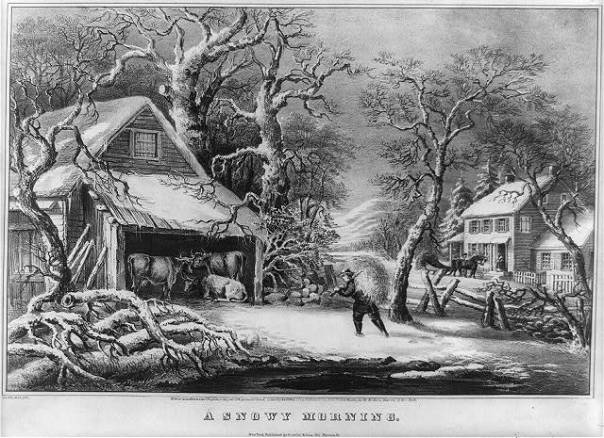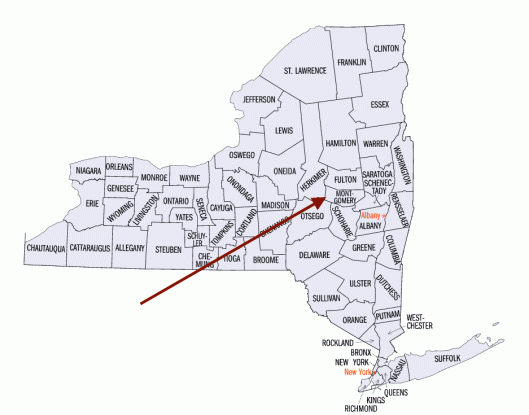The fifth prompt offered by Amy Johnson Crow in the 52 Ancestors in 52 Weeks Challenge is “Plowing Through”. In response to this prompt I’d like to introduce you to my farmer kin, John W Hall.

1 print : lithograph. | Print shows a farmer carrying a bundle of hay on his back to feed some cows huddled under cover outside a barn during winter.
Contributor: Currier & Ives – Palmer, F. (Fanny)
Original Format: Photos, Prints, Drawings Date: 1864
http://www.loc.gov/pictures/item/2001706219/
I confess, sometimes when researching family I play favorites. It may be that a particular ancestor’s experience relates to something in my own life, or that I deeply admire a particular ancestor. It’s really difficult for me to identify what it is about the John W Hall family that places them on my favorites list but they are without a doubt there. I’ve enjoyed researching the Halls and have had the chance to visit the hometown of John W Hall.
John W Hall was a lifelong resident of Charleston, Montgomery County, New York. (Part of Charleston was portioned off to give rise to the new town of Glen) It is likely he was born there, son of William Hall and Jannetje Covenhoven. (For more on the parents of John W. Hall please see footnote 1)[i].

Courtesy US Census bureau. http://quickfacts.census.gov/qfd/maps/new_york_map.html
In 1825, John and his siblings transacted land left to them in their father, William Hall’s, will. At the end of these transactions, John remained with 64 acres of the original family farm and his older brother Peter retained about 250 acres. Two years later, John sold his 64 acres to his brother-in-law Nicholas, and purchased a farm of about 70 acres at the Charleston/Glen border. About 5 years later he bought another 50 acres of land adjacent to his farm. Census records indicate the farm increased in size and by 1850 it was a total of about 220 acres. The land was partly in the town of Charleston and partly in Glen, and often John W Hall can be found in both towns.
![Clipped map from Ancestry.com, annotated to show area of J.W. Hall farm at Charleston/Glen border. [Ancestry.com, U.S., Indexed County Land Ownership Maps, 1860-1918 (Provo, UT, USA, Ancestry.com Operations, Inc., 2010), Ancestry.com, Collection Number: G&M_9; Roll Number: 9. Record for J W Hall.]](https://digginupdeadpeople.wordpress.com/wp-content/uploads/2015/01/snip20150127_1.png?w=626&h=463)
Clipped map from Ancestry.com, annotated to show area of J.W. Hall farm at Charleston/Glen border. [Ancestry.com, U.S., Indexed County Land Ownership Maps, 1860-1918 (Provo, UT, USA, Ancestry.com Operations, Inc., 2010), Ancestry.com, Collection Number: G&M_9; Roll Number: 9. Record for J W Hall.]
By the 1860 census, John W was farming a total of 140 acres of land. The 1865 NYS census agricultural schedule shows the farm was worth $5470 (land, stock and tools) and consists of 110 improved and 10 unimproved acres. The farm is also the same acreage in 1870; it is likely parts of his farm were given or leased to his sons as the years went by. On the farm, he grew grains including wheat, oats, rye, barley, buckwheat, Indian corn, and potatoes. There were also apple orchards and sugar maples from which molasses are made. Animals on the farm included cattle (primarily dairy), horses, swine, sheep and poultry. A main product of the farm was butter. Even as the size of the farm decreased, production of butter increased.
John raised his family on his farm. He likely married his wife, Maria, about 1811, record has not been found. Their first two children were born in Cayuga County in 1812 and 1815; Maria’s presumed parents had moved from Montgomery County and lived there at the time. It appears that John and Maria stayed close to her parents for the very first years of their marriage and then returned to Montgomery County by the time their third child was born in 1816. In total, John and Maria had 11 children between the years 1812 and 1839. The 1840 census was the first to ask about agriculture and at that time it was reported 5 people in the household of John W Hall were employed in agriculture. Census records do not show farm laborers lived on his farm; it appears the farm was family-run and maintained. As his sons married, they also became farmers of their own properties in the same area. Youngest son, John P Hall remained at the family farm. Upon John W Hall’s death, the farm was left by his last will and testament to his sons, and legacies were paid to his daughters. John P. Hall purchased the shares from his siblings and stayed there until 1924 when he sold the farm.

“1875 NYS Census,” Charlestown, Montgomery, New York, digital image, Family Search, Family History Library, Salt Lake City, Utah., familysearch.org, Sept 2011, Schedule III, Deaths, Charlestown, ED 02, [image 13 of 20] p 6, line 1.
![“Mohawk Valley Notes,” The Albany Argus, Monday, September 28, 1874, [digital image online], Albany, New York, Vol XLVIII, Issue 18115, Page 4, Genealogybank.com, (http://www.genealogybank.com).](https://digginupdeadpeople.wordpress.com/wp-content/uploads/2015/01/snip20150124_7.png?w=762&h=178)
“Mohawk Valley Notes,” The Albany Argus, Monday, September 28, 1874, [digital image online], Albany, New York, Vol XLVIII, Issue 18115, Page 4, Genealogybank.com, (http://www.genealogybank.com). [Although the obituary says Green, actually the town is Glen. The town of Green is not in Montgomery County.]
I’ve had the opportunity to visit the towns of Charleston and Glen in Montgomery County. New York. I’ve driven the road to the old farm. I’ve walked the cemetery where John, his wife Marie and some of his children are buried. I’ve also been to the cemetery where some of his brothers and grandchildren were buried. Although geographically, the area where he lived is not terribly distant from my current home, it was still a very moving experience to be where they were. The area is still predominantly agricultural, lending to the experience. Sadly, many old farms had been abandoned or neglected as people moved out of the business of agriculture. In recent decades, the area has seen an agricultural renewal and is now home to a large Amish community. Driving on roads shared with horses and buggies as well as horse drawn wagon teams helped me to imagine in some small part what it must’ve been like for my ancestors who lived there.
Current Zillow information on the former John W Hall farm.
http://www.zillow.com/homedetails/224-Furmer-Rd-Fultonville-NY-12072/31055733_zpid/
[i] John W Hall was born about 1785 in Charleston, Montgomery, New York. To discover the parents of John W Hall is challenging, as there are several candidates in the area.
Land records, used alongside probate records have proven useful in determining the likely set of parents of John W Hall.
In the record of baptisms of the Reformed Dutch Church at Caughnawaga (Near Fonda), Montgomery, New York there is a baptism of a Johannis Hall, 10 February 1787, no birth date specified. Parents are William W Hall and Jannetje Covenhoven.
In the record of baptisms of the Reformed Dutch Church at Schenectady, Schenectady, New York, there is a baptism of a John Hall, 20 Nov 1785, born 14 Oct 1785. Parents are William Hall and Annatje Barheyt. This birth date is closest to the date I’ve calculated from the date and age listed on John’s tombstone. However, the other children born to William and Annatje do not match the names in the last will and testament of the William Hall that left land, which was later transacted.
The will of William Hall, probable father to John W Hall, names son John Hall Junior. It has been found that there is another John W Hall in the area. This older John W Hall is married to a woman named Catherine. Records have shown this John W Hall is in the town of Mohawk, Montgomery, NY. Junior did not necessarily denote the son of a John W Hall, but could be any relation, eg the older relation could be a grandfather or uncle.
The will listed above that names John W Hall would suggest that the parents of John W are WIlliam and Jean (Jannetje). The names in the will are more consistent with the baptisms of William Hall and Jannetje Covenhoven. In addition, the land that is bequeathed to the children is in the area of Montgomery County that John W Hall is known to have transacted. John W Hall is involved in several land transactions regarding this and the farm on which he will ultimately reside. The siblings, who then sold all their shares to brother Peter Hall, inherited the land. John buys back a portion from Peter consisting of 64 acres. John W Hall later sells these 64 acres to Nicholas Clute. On the same day and time that transaction is recorded, another land transaction, a purchase of land is recorded. This land purchase is the land later bequeathed to John W Hall’s children in his last Will and Testament, and described in later land transactions between and among those children.
One thought on “Week 5: Plowing Through: John W Hall”